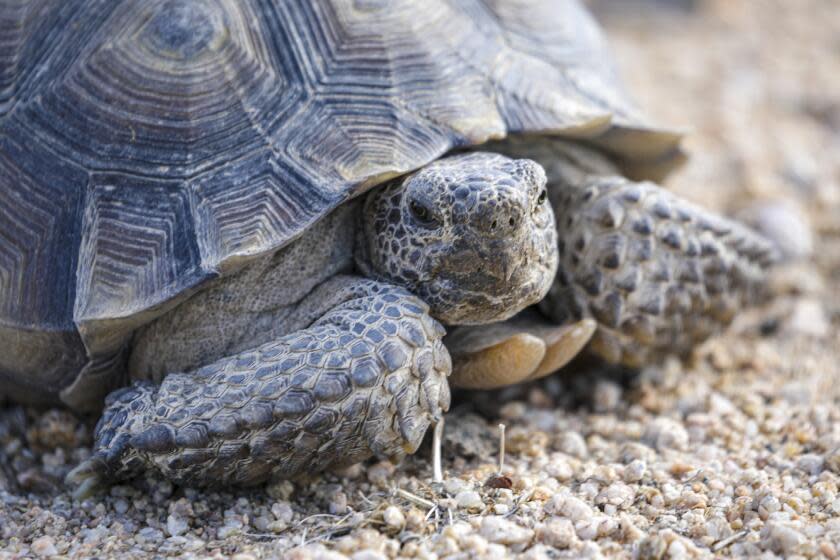Good news for desert tortoises: Stretch of Mojave Desert gets federal protections

A 3.5-million-acre swath of Mojave Desert between Ridgecrest and the Morongo Basin has received a new federal designation that advocates hope will help protect vulnerable wildlife like the Mojave desert tortoise.
The area has been named a sentinel landscape, a federally led effort to promote sustainable land-use practices near military installations.
“It’s built on partnerships,” said Phil Murray, encroachment manager for the Marine Corps Air Ground Combat Center in Twentynine Palms, one of five installations that surrounds the newly designated land. “A lot of the conservation work that’s done around the Morongo Basin or Mojave Desert is coordinated through different federal agencies, NGOs and private partners.”
The goal is to encourage a more collaborative approach, and to streamline federal assistance to the various agencies, groups and people involved, he said.
The designation doesn’t change who owns or manages the land and does not come with dedicated funding, aside from money for an implementation plan and a coordinator, Murray said. But sentinel landscapes are prioritized for funding through certain grants, he said.
Read more: He picked up a package and found a live rattlesnake inside: 'Do I have any enemies?'
The coalition is expected to support conservation efforts such as erecting desert tortoise fencing to reduce vehicle strikes, creating wildlife crossings, propagating seeds and rehabilitating habitat, including areas that have burned in wildfires, Murray said.
The Mojave Desert Land Trust expects to do much work on the ground, including helping with seed collection and outreach, said Cody Hanford, deputy executive director and chief conservation officer of the nonprofit dedicated to protecting the California desert.
“It will elevate our projects, elevate our goals, which I think in the end will help them become more accomplishable,” he said.
Other partners include various federal and state agencies, conservation groups and San Bernardino County.
Read more: Joshua Tree's celebrity rattlesnake wrangler wants to change how you see reptiles
The expanse of desert that received the designation is ringed by the Marine Corps Air Ground Combat Center, National Training Center Fort Irwin, Edwards Air Force Base, Naval Air Weapons Station China Lake and Marine Corps Logistics Base Barstow.
It’s also the heart of desert tortoise habitat in California, said Ken MacDonald, board member at-large and former president of the Desert Tortoise Council conservation group, a partner in the new effort.
“There’s recreational interests, tribal interests, local community interests,” he said. “So coming together as a partnership, we thought, would make the coalition and the cooperation more effective than everybody chipping away and working independently in their own backyard.”
“And so really, it’s to manage the whole 3 million acres cooperatively and collaboratively and be more effective in conserving and recovering the desert tortoises, and that’s pretty much it,” he said. “Just team up and take care of these critters.”
The stretch of desert includes at least 40 other protected species, including the Western Joshua tree, which California has protected with a conservation plan, and the Mohave ground squirrel, which the state lists as threatened.
Read more: How large fires are altering the face of California's Mojave Desert
But perhaps none is as imperiled as the desert tortoise, which California recently listed as endangered.
The species is facing pressure from a number of fronts, MacDonald said. The slow-moving reptiles are vulnerable to being hit by cars. Development has carved up previously wide-open stretches of desert into parcels that are in some cases too small to allow for the breeding and genetic diversity needed to sustain their population health. Drought conditions meant the wildflowers they like to eat never grew some years, and invasive species outcompeted them in other years.
And so-called human-subsidized predators, including ravens and coyotes, have followed people into these previously undeveloped areas, perching on the structures they build and feeding on their trash, MacDonald said. They find relatively easy meals in juvenile tortoises, whose shells tend to remain soft until they’re at least 5 years old. They don’t typically reproduce for another eight to 10 years after that, he said.
Climate change has raised the stakes by ensuring conditions are hotter and drier than the desert tortoises are adapted to, Hanford said.
“They have to live within these small climate margins,” he said. “Climate change is threatening those margins.”
Read more: Joshua Tree’s famed three-legged coyote Tripod is in danger of being loved to death
Already, the Twentynine Palms combat center has a head start program, in which they work with UCLA to identify and monitor tortoise burrows, Murray said. Once females lay eggs, scientists incubate them in a facility on base. They let the tortoises grow in pens for five to seven years until their shells harden, then they release them back into the wild.
The Department of Defense also restricts explosive ordnance training in areas with high concentrations of desert tortoises, and Marines receive training on how to avoid them and how to handle them if they need to be moved away from a road or target site, Murray said.
The sentinel landscapes program was established in 2013 as a partnership of the departments of Agriculture, Defense and the Interior. Other newly designated sites include areas in New Mexico, Utah, Hawaii and Pennsylvania. The portion of land named in the Mojave is California’s first.
As the state's population continues to surge inland, the stretch of desert will also be targeted by future development and all the infrastructure that comes with it, Hanford said.
“So it makes a lot of sense to focus here,” he said. “Because if we’re going to save the desert tortoise, this area that has been identified is required to be managed properly.”
Read more: Mojave desert tortoise officially joins California's endangered list
This story originally appeared in Los Angeles Times.

